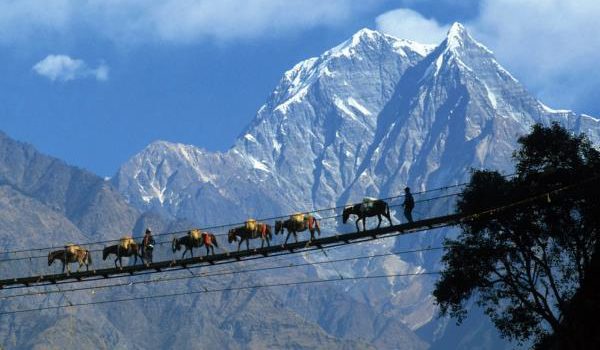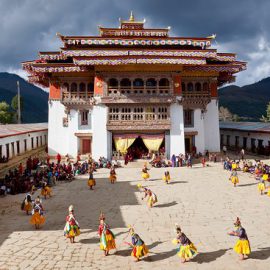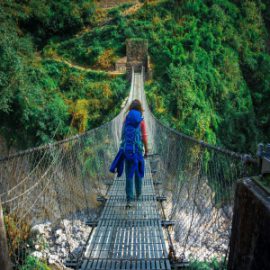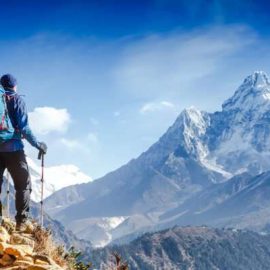
The Druk Path Trek is a moderate six days’ trek program. This trek offers beautiful views as you cross the chain of mountains separating Paro and Thimphu valleys. This route is also famous for its spectacular rhododendron bushes and wonderful high altitude lakes. You will come across a few temples and a dzong on the way. Majestic view of Himalayas is also seen on a clear weather of late autumn and winter seasons. You can also go for a short day’s excursion to the Punakha valley to visit the magnificent Punakha Dzong.
Seasons: This trek is usually possible from late February to June and from September to December.
Day 01: Arrive Paro
On arrival at Paro you will be received by our travel representative and transferred to hotel in Paro. Overnight at the hotel in Paro.
Day 02: Paro Sightseeing
Drive northwest up the valley to Drukgyel Dzong, built in 1646 by Shabdrung Ngawang Namgyal to commemorate his victory over the Tibetan invaders. Though largely destroyed by fire in 1951, its towering walls are still an imposing sight. On a clear day you can view Mt. Jhomolhari from inside the ruin of Drukgyel Dzong. A few typical village houses can be visited near the dzong. Visit Kyichu Lhakhang on the way which is one of the oldest and most sacred shrines of Bhutan. In the afternoon visit the National Museum and walk down the hillside trail to visit Rinpung Dzong (Paro Dzong), “the fortress of the heap of jewels”.
Day 03: Hike to Taktsang ( Paro)
This is the acclimatization day for you and begins an early morning hike to the Takshang monastery. In this exercise, you will be gaining roughly around 800 meters in less than three hours. Lunch will be served in the cafteria below the monastery. Evening at leisure.
Day 04: Paro – Jeledzong
Today is a short trekking day. The journey starts with a short climb upto Jele Dzong. The trek trail ascends gradually up to the campsite and on a clear weather you can have a good view of Paro valley. Above the camp is Jele-la pass (3,400m) and Jele Dzong in ruins. There is also a monastery with a statue of Buddha Sakyamuni in it. It takes about 3 hours to reach the campsite. Overnight stay at the camp.
Day 05: Jeledzong – Jangchu Lhakhang
The trail ascends slight sharp uphill for one and half hour and then the gradual path upwards. The trail will passes through the thick alpine forests and rhododendrons. On a fine day you will have clear view of Jhomolhari and other snow capped peaks. You may hear some monal pheasants calling during the day. You may also see yak herders around your campsite. Overnight stay at the camp.
Day 06 : Jangchu Lhakhang – Jimilangtso
The trail follows the ridge and on a clear day the views of the mountains and valley are breathtaking. You will enjoy a great view of mount Jichu Drake (6,989m). Our camp is close to the Jimilangtsho lakes which are famous for their giant sized trout. Overnight stay in the camp.
Day 07: Jimilangtso –Simkota
The trail takes you through dwarf rhododendron trees and passes by the lake of Janetsho. Today you may come across some yak herders’ camps and get an idea of their lifestyle up in the mountains as nomads. We camp overnight close to Simkota Lake.
Day 08: Simkota-Phajoding
Today begins with a gradual climb and if the weather permits, you will enjoy majestic views of Mt. Gangkar Puensum and a host of other peaks. The trail slowly descends through juniper trees to a campsite at Phajoding. Overnight stay in the camp.
Day 09: Phajoding – Thimphu
The trek to Thimphu is all the way downhill passing through the forested area of mostly blue pine. On a leisurely pace you can reach Thimphu in about 3 hours’ time. In the afternoon do the sightseeing of the following places of interest based on the available time in hand:
National Memorial Chorten – built as a memorial to the Bhutan’s third king (“the father of modern Bhutan”) and as a monument to world peace.
Tashichhodzong – the impressive fortress housing some ministries, His Majesty’s secretariat, and the central monk body.
Handicrafts Emporium – a wide assortment of hand-woven textiles and other craft products available for purchase at this government-run outlet.
National Library – established in the late 1960s primarily to conserve the literary treasures of Bhutan. It now holds an extensive collection of Buddhist texts and manuscripts.
Institute for Zorig Chusum, more commonly known as the Painting School where students learn the 13 traditional arts and crafts of Bhutan.
National Institute of Traditional Medicine (see from outside only) – herbal medicines from medicinal plants abundantly found in the kingdom are processed here. Training of traditional medicine practitioners, treatment and dispensing of the traditional medicines are also done.
Overnight stay in hotel at Thimphu.
Day 10: Thimphu – Punakha-Wangdue -Thimphu
After the breakfast a full day excursion to the Punakha and Wangdue valleys will be done. The drive from Thimphu crosses Dochu-la pass (3,088m) from which there are the most enchanting mountain views are seen. In Punakha visit Punakha Dzong situated at the junction of the Pho Chu and Mo Chu rivers. It was built in the 17th century by Shabdrung Ngawang Namgyal and this dzong has played various roles as historic monument of the nation. Then drive to Wangduephodrang to visit 17th century Wangduephodrang Dzong and the local market. In the evening drive back to Thimphu and overnight stay at the hotel in Thimphu.
Day 11: Thimphu – Paro
Our travel guide will see you off at the Paro Airport for your onward flight.
Note: This trek is of medium difficulty range. The trek involves of 6-7 hours a day of walking and the elevation may go upto 4000M above sea level. Physical fitness of average level is good enough and should be a good nature lover to enjoy this trek.



